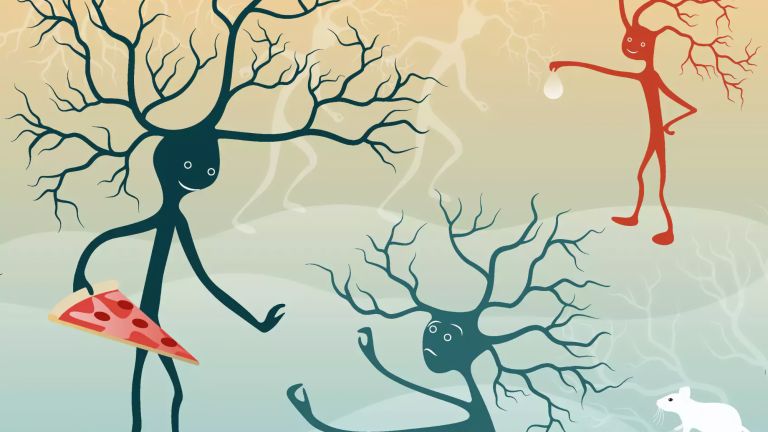Thirst and hunger neurons

New research shines light on how the brain interprets nutritional and hydration needs and turns them into action.
Veröffentlicht: 31.03.2025
- Hunger und Durst: Forschende haben Nervenzellen in der Amygdala identifziert, die über verschiedene Schaltkreise das Verlangen nach Essen oder Trinken beeinflussen.
- Spezialisten und Generalisten: Eine dieser Nervenzellgruppen reguliert ausschließlich das Bedürfnis zu trinken. Eine andere Gruppe ist ebenfalls für Durst zuständig, spielt aber auch eine Rolle bei der Regulierung des Hungergefühls.
- Kartierung der Kommunikationswege: Die Nervenzellen stehen mit Hirnregionen in Verbindung, die sensorische Informationen über Nahrung und Wasser verarbeiten.
- Neue Vorliebe: Eine Stimulation von Nervenzellen in der Amygdala machte aus einem zuvor gemiedenen Geschmack das neue Lieblingsgetränk.
Amygdala
Amygdala/Corpus amygdaloideum/amygdala
Ein wichtiges Kerngebiet im Temporallappen, welches mit Emotionen in Verbindung gebracht wird: es bewertet den emotionalen Gehalt einer Situation und reagiert besonders auf Bedrohung. In diesem Zusammenhang wird sie auch durch Schmerzreize aktiviert und spielt eine wichtige Rolle in der emotionalen Bewertung sensorischer Reize. Darüber hinaus ist sie an der Verknüpfung von Emotionen mit Erinnerungen, der emotionalen Lernfähigkeit sowie an sozialem Verhalten beteiligt. Die Amygdala – zu Deutsch Mandelkern – wird zum limbischen System gezählt.
The amygdala, a brain region often linked to emotions and decision making, also plays a key role in shaping our desire to eat and drink. Earlier research led by Rüdiger Klein’s group at the Max Planck Institute for Biological Intelligence revealed that neurons in the central nucleus of the amygdala connect food to feelings – pairing tasty meals with positive emotions, associating bad food with aversion, and suppressing appetite when nausea sets in. The team also demonstrated that changing the activity of these neurons can alter behavior, prompting mice to eat even when they are full or feeling unwell.
Building on these findings, the new research has detailed distinct groups of neurons in the same central region of the amygdala that respond specifically to thirst and others that respond to hunger, guided by a complex web of molecular cues. “One of these groups of neurons is solely dedicated to regulating the desire to drink, the first ‘thirst neuron’ that has been identified in the amygdala,” explains Federica Fermani, who led the study. “When we activated these neurons, the mice drank more, and when we suppressed their activity, the mice drank less. We also identified another group of neurons in the same region of the amygdala that drives thirst but also plays a role in regulating hunger. These findings highlight how some neurons show remarkable specialization for specific behaviors, while others have more general roles in guiding food and drink choices.”
To explore how neurons in the central nucleus of the amygdala regulate drinking and eating, the researchers used advanced genetic tools to study brain activity in mice during hunger, thirst, and when they were already full and hydrated. One method, called optogenetics, allowed the team to activate specific neurons using light-sensitive proteins and a laser precisely tuned to trigger those cells. They also used approaches to silence the neurons, observing how their absence influenced the mice’s tendency to eat or drink. By combining this with new methods that enable the monitoring of individual neurons across multiple brain regions, the researchers mapped where these neurons receive information and identified other brain regions they communicate with.
Raising new questions
Mapping the pathways these neurons use to communicate with other brain regions revealed connections to areas involved in processing sensory information about food and water, such as the parabrachial complex. The study also explored how the brain balances other factors, such as taste, in shaping behavior. For example, by pairing a less-preferred drink flavor with targeted stimulation of neurons in the central amygdala, the researchers found they could change the mice’s choices, transforming a previously avoided flavor into a new favorite. Since the amygdala’s structure is similar in mice and humans, the researchers suggest these findings could improve our understanding of how emotions and motivations influence our own eating and drinking habits.
“Basic drives like thirst and hunger ensure we eat and drink at the right times, giving our bodies the hydration and nutrition needed to survive,” explains Rüdiger Klein, Director at the Max Planck Institute for Biological Intelligence. “But these same neural circuits can also contribute to overeating or undereating, depending on the signals they encounter in the brain. By uncovering these processes, we gain a better understanding of how the brain emotionally evaluates food and drink, learns to associate them with pleasure or aversion, and how neural development shapes both innate and learned behaviors.”
This work opens the door to new questions – such as how the brain balances appetite, thirst, and emotions; how we know when we’ve had too little or too much to eat and drink; how competing needs are managed simultaneously; and how these circuits are affected in conditions like obesity, anorexia, or alcohol addiction.
Original publication
Federica Fermani, Simon Chang, Ylenia Mastrodicasa, Christian Peters, Louise Gaitanos, Pilar L. Alcala Morales, Charu Ramakrishnan, Karl Deisseroth & Rüdiger Klein; Food and water intake are regulated by distinct central amygdala circuits revealed using intersectional genetics; Nature Communications, online 29 March 2025
DOI